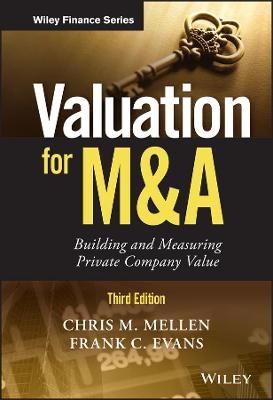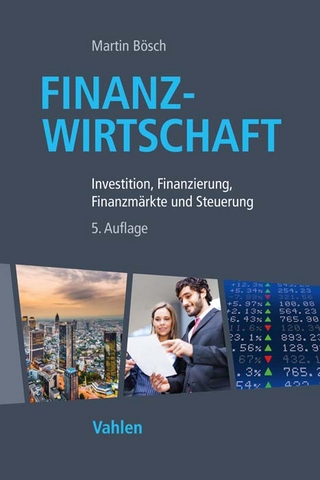
Valuation for M&A
John Wiley & Sons Inc (Verlag)
978-1-119-43383-5 (ISBN)
Valuation for M&A lays out the steps for measuring and managing value creation in non-publicly traded entities, and helps investors, executives, and their advisors determine the optimum strategy to enhance both market value and strategic value and maximize return on investment.
As a starting point in planning for a transaction, it is helpful to compute fair market value, which represents a “floor” value for the seller since it by definition represents a value agreed upon by any hypothetical willing and able buyer and seller. But for M&A, it is more important to compute investment value, which is the value of the target company to a strategic buyer (and which can vary with each prospective buyer).
Prepare for the sale and acquisition of a firm
Identify, quantify, and qualify the synergies that increase value to strategic buyers
Get access to new chapters on fairness opinions and professional service firms
Find a discussion of Roger Grabowski's writings on cost of capital, cross-border M&A, private cost of capital, intangible capital, and asset vs. stock transactions
Inside, all the necessary tools you need to build and measure private company value is just a page away!
CHRIS M. MELLEN is a managing director with Valuation Research Corporation who leads its Boston office. Previously, he was president of Delphi Valuation Advisors, Inc., which he founded in 2000 and sold to VRC in 2015. Mellen is the author of numerous articles on valuation-related topics and coauthor of the second edition and author of the third edition of Valuation for M&A. FRANK C. EVANS is the founder of Evans and Associates Valuation Advisory Services. A prolific educator and speaker, he is coauthor of the first and second editions of Valuation for M&A.
Preface xi
Dedication and Acknowledgments xv
PART I Introduction 1
Chapter 1 Winning through Mergers and Acquisitions 3
Critical Values Shareholders Overlook 5
Stand-Alone Fair Market Value 6
Investment Value to Strategic Buyers 8
Win–Win Benefits of Merger and Acquisition 10
Computation of Cavendish’s Stand-Alone, Fair Market Value 11
Investment Value to Strategic Buyer 12
PART II Building Value 15
Chapter 2 Building Value and Measuring Return on Investment in a Private Company 17
Public Company Value Creation Model 17
Computing Private Company Value Creation and ROI 19
Analyzing Value Creation Strategies 35
Chapter 3 Market and Competitive Analysis 41
Linking Strategic Planning to Building Value 43
Assessing Specific Company Risk 48
Competitive Factors Frequently Encountered in Nonpublic Entities 53
Financial Analysis 54
Conclusion 59
Chapter 4 Merger and Acquisition Market and Planning Process 61
Common Seller and Buyer Motivations 64
Why Mergers and Acquisitions Fail 65
Sales Strategy and Process 67
Acquisition Strategy and Process 78
Due Diligence Preparation 86
Chapter 5 Measuring Synergies 91
Synergy Measurement Process 92
Key Variables in Assessing Synergies 95
Synergy and Advance Planning 96
PART III Measuring Value 99
Chapter 6 Valuation Approaches and Fundamentals 101
Business Valuation Approaches 101
Using the Invested Capital Model to Define the Investment Being Appraised 103
Why Net Cash Flow Measures Value Most Accurately 104
Frequent Need to Negotiate from Earnings Measures 106
Financial Statement Adjustments 109
Managing Investment Risk in Merger and Acquisition 112
Conclusion 117
Chapter 7 Income Approach: Using Expected Future Returns to Establish Value 119
Why Values for Merger and Acquisition Should Be Driven by the Income Approach 119
Two Methods within the Income Approach 121
Three-Stage DCF Model 128
Establishing Defendable Long-Term Growth Rates and Terminal Values 131
DCF Challenges and Applications 133
Chapter 8 Cost of Capital Essentials 135
Cost of Debt Capital 136
Cost of Preferred Stock 138
Cost of Common Stock 138
Fundamentals and Limitations of the Capital Asset Pricing Model 139
Modified Capital Asset Pricing Model 142
Build-Up Model 143
Summary of Rate of Return Data 151
Private Cost of Capital 153
International Cost of Capital 156
How to Develop an Equity Cost for a Target Company 157
Reconciling Discount Rates and P/E Multiples 159
Conclusion 161
Appendix 8A Using Specific Company Risk Strategically 162
Chapter 9 Weighted Average Cost of Capital 169
Iterative Weighted Average Cost of Capital Process 170
Shortcut Weighted Average Cost of Capital Formula 174
Common Errors in Computing Cost of Capital 176
Chapter 10 Market Approach: Using Guideline Public Companies and M&A Transactions 181
Transaction Multiple Method 182
Guideline Public Company Method 186
Selection of Valuation Multiples 190
Commonly Used Market Multiples 191
Chapter 11 Asset Approach 199
Book Value versus Market Value 200
Premises of Value 201
Use of the Asset Approach to Value Noncontrolling Interests 201
Adjusted Book Value Method 202
Specific Steps in Computing Adjusted Book Value 207
Chapter 12 Adjusting Value through Premiums and Discounts 209
Applicability of Premiums and Discounts 210
Application and Derivation of Premiums and Discounts 211
Apply Discretion in the Size of the Adjustment 213
Control versus Lack of Control in Income-Driven Methods 215
Fair Market Value versus Investment Value 215
Chapter 13 Reconciling Initial Value Estimates and Determining Value Conclusion 217
Essential Need for Broad Perspective 217
Income Approach Review 220
Market Approach Review 225
Asset Approach Review 226
Value Reconciliation and Conclusion 228
Checks to Value 231
Candidly Assess Valuation Capabilities 232
Valuation Scenarios – Platform for M&A 232
Appendix 13A Disciplined and Thorough Valuation Analysis Key to Avoiding Failed M&A Deals 235
Analysis of a Hypothetical Synergistic Deal 235
Establishing the Value of an Acquisition Target 236
Establishing Value for the Acquirer 238
Considerations of Other Impacts on Value 239
PART IV Specialty Issues 241
Chapter 14 Exit Planning 243
Why Is Exit Planning So Difficult? 244
What Makes Planning for Your Private Company Investment Unique? 247
Why Should Exit Planning for Your Private Company Begin Now? 249
Exit Planning Process 250
Step 1: Setting Exit Goals 252
Step 2: Owner Readiness 254
Step 3: Type of Exiting Owner 256
Step 4: Exit Options 258
Step 5: Range of Values 263
Step 6: Execution of Exit Plan 265
Chapter 15 Art of the Deal 269
Unique Negotiation Challenges 269
Deal Structure: Stock versus Assets 271
Asset Transaction 276
Terms of Sale: Cash versus Stock 279
Personal Goodwill 282
Bridging the Gap 283
See the Deal from the Other Side 286
Chapter 16 Fairness Opinions 289
Why Are Fairness Opinions Obtained? 291
The Use of Fairness Opinions by Private Companies 294
Parties Who Prepare Fairness Opinions 295
Components of a Fairness Opinion 297
What Fairness Opinions Are Not 301
Conclusion 302
Appendix 16A Sample Fairness Opinion Letter 303
Chapter 17 M&A and Financial Reporting 309
U.S. GAAP and IFRS 310
Relevant FASB and IFRS Statements 311
Reviews by the Audit Firm 312
ASC 820: Fair Value Measurements 313
ASC 805: Business Combinations 315
ASC 350: Goodwill and Other Intangible Assets 325
Incorporating ASC 805 into the Due Diligence Process 326
References 329
Chapter 18 Intangible Asset Valuation 331
Approaches to Valuing Intangible Assets 332
Key Components to Intangible Asset Valuation 334
Intangible Asset Valuation Methods 343
Conclusion 352
Chapter 19 Measuring and Managing Value in High-Tech Start-Ups 353
Why Appraisals of High-Tech Start-Ups Are Essential 353
Key Differences in High-Tech Start-Ups 355
Value Management Begins with Competitive Analysis 356
Stages of Development 358
Risk and Discount Rates 360
Start-Ups and Traditional Valuation Methods 361
QED Survey of Valuation Methods Used by Venture Capitalists 367
A Probability-Weighted Scenario Method to Value Start-Ups 372
Equity Allocation Methods 377
Conclusion 380
Chapter 20 Cross-Border M&A 381
Strategic Buy-Side Considerations 381
Due Diligence 390
Sell-Side Considerations 395
PART V Case Studies 397
Chapter 21 Merger and Acquisition Valuation Case Study – Distribution Company 399
History and Competitive Conditions 400
Potential Buyers 401
General Economic Conditions 402
Specific Industry Conditions 403
Growth 404
Computation of the Stand-Alone Fair Market Value 404
Risk and Value Drivers 409
Summary and Conclusion of Stand-Alone Fair Market Value 418
Computation of Investment Value 420
Suggested Considerations to Case Conclusion 427
Chapter 22 Merger and Acquisition Valuation Case Study –Professional Services Firm 429
Characteristics 429
Valuation Methods 433
Case Study Introduction 435
Potential Buyer 435
Historic Financial Performance 436
Future Expectations 439
Risk and Value Drivers 443
Discounted Cash Flow Method 445
Other Valuation Methods to Consider 445
Suggested Considerations to Case Conclusion 451
About the Authors 453
Glossary 455
Index 465
| Erscheinungsdatum | 13.06.2018 |
|---|---|
| Reihe/Serie | Wiley Finance |
| Verlagsort | New York |
| Sprache | englisch |
| Maße | 142 x 231 mm |
| Gewicht | 726 g |
| Themenwelt | Wirtschaft ► Betriebswirtschaft / Management ► Finanzierung |
| Wirtschaft ► Betriebswirtschaft / Management ► Planung / Organisation | |
| ISBN-10 | 1-119-43383-5 / 1119433835 |
| ISBN-13 | 978-1-119-43383-5 / 9781119433835 |
| Zustand | Neuware |
| Informationen gemäß Produktsicherheitsverordnung (GPSR) | |
| Haben Sie eine Frage zum Produkt? |
aus dem Bereich


